We are a homeschooling family and this post appeared on my sadly neglected homeschool blog The Fig Tree. These days my kids don't appreciate mum blogging about everything they do but this post has some good information for doing art with all kids. It also reflects my philosophy in the way I teach art to anyone- kids and grown up kids are all welcome to play and experiment in my art space. All of the works on this post were done by my own children at home.
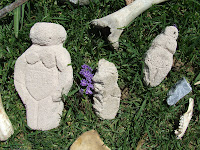
Art can be easily overlooked in the homeschool, some parents have shared with me how they find it difficult to fit it in, it is very valuable to your child's education though so I thought I would share some thoughts and resources here.
I am passionate about art in our homeschool.

Art can be easily overlooked in the homeschool, some parents have shared with me how they find it difficult to fit it in, it is very valuable to your child's education though so I thought I would share some thoughts and resources here.
I am passionate about art in our homeschool.
Most of the things we do in life have well defined procedures to follow, rules and regulations leaving little room for creativity or mistakes.
Art is wonderful to open a child's mind to freedom and play; to allow them to experiment and to use their own imaginations without any fear of getting it wrong-
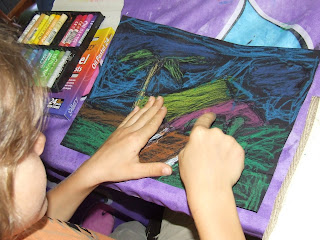
ART
is
FUN,
SPONTANEOUS
and
RELAXING.
Art is wonderful to open a child's mind to freedom and play; to allow them to experiment and to use their own imaginations without any fear of getting it wrong-

ART
is
FUN,
SPONTANEOUS
and
RELAXING.

Why learn Art?
Learning art provides a foundation for visual perception, the ability to recognise and understand images, these may be found in many places- art works, plans/ blueprints, symbols, words.......
Art education helps a child to develop abstract thinking skills-
the visual arts combine abstract thinking with real concrete materials
to create the idea in their imagination,
using convergent, divergent, evaluative and visual thinking skills.
Art education provides a window
a connection into people in another place and time.
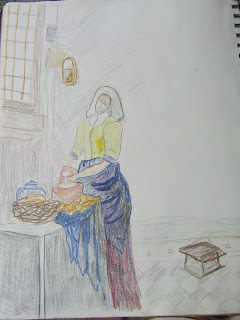
Art education encourages creativity using art skills and knowledge-
in order to create children utilise other Key Learning Areas
Maths- patterns.
Science- colours- mixing, tones, opposites.
Language Arts- communication- expressing ideas, discussing art works
reading or listening to directions.
- history- people have made art in most cultures and most times, studying art from different times is like a window into that time and kids notice details they wouldn't pick up from a book or lesson. Recreating art from times past is also a wonderful way to add depth to a study of that time and place.
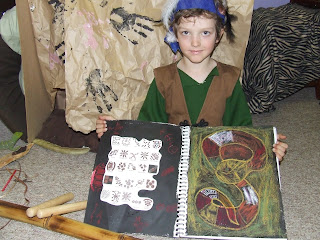
Physical ed- motor skills, some art materials are heavy and use a lot of muscle- clay in pottery and sculpting a heavy base.
How to Incorporate art into your homeschool.
Children need to see art to appreciate its beauty and power-
Look at pictures together, and talk about what you see, there are many lovely books with wonderful reproductions of great artworks and libraries have great collections.
Calenders often feature an artists well known works and can be easily collected and stored till you need them.
Visit art galleries and art shows.
Study different artists and different styles of art.
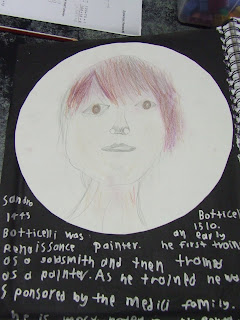
Making art is fun.
How often in your school time do you really get to do something spontaneous and hands on?
Art can easily be included in your homeschool days-
it fits really well with unit studies or into set subjects,
especially science- nature journalling
Geography- salt dough maps or mountains or volcanoes, sketched or painted landscapes and History.
My personal goals for my kids are to teach them to be comfortable and familiar with how to use various art materials so they are willing to use them to express themselves freely.
The materials we use, we play with, but they learn as much from the art materials themselves as they do from me.
I am aiming for my boys to find success and pleasure in our art time.
We use a lot of student grade art materials in our home, I find they have a good range, the are good value and quite good quality for our uses. I tend to pick up things as I plan them and I include art planning in my general homeschool planning.
I also give the more precious art materials to my boys at birthdays and solstices as gifts, they enjoy having their own supplies and use them in their own time.
We also use lots of recycled materials, there are always clean recyclable things around- paper, cardboard, tubes, bottles, lids containers etc, many can be used in assemblages or art works and others can be used to store art materials.
A couple of my favorite books for teaching art
Discovering Great Artists
MaryAnn F Kohl and Kim Solga
and
The Art Teachers Book of Lists
Helen D. Hume
The Internet is a wonderful source of inspiration and ideas
here are some of our favourites.
Learning art provides a foundation for visual perception, the ability to recognise and understand images, these may be found in many places- art works, plans/ blueprints, symbols, words.......
Art education helps a child to develop abstract thinking skills-
the visual arts combine abstract thinking with real concrete materials
to create the idea in their imagination,
using convergent, divergent, evaluative and visual thinking skills.
Art education provides a window
a connection into people in another place and time.

Art education encourages creativity using art skills and knowledge-
in order to create children utilise other Key Learning Areas
Maths- patterns.
Science- colours- mixing, tones, opposites.
Language Arts- communication- expressing ideas, discussing art works
reading or listening to directions.
- history- people have made art in most cultures and most times, studying art from different times is like a window into that time and kids notice details they wouldn't pick up from a book or lesson. Recreating art from times past is also a wonderful way to add depth to a study of that time and place.

Physical ed- motor skills, some art materials are heavy and use a lot of muscle- clay in pottery and sculpting a heavy base.
How to Incorporate art into your homeschool.
Children need to see art to appreciate its beauty and power-
Look at pictures together, and talk about what you see, there are many lovely books with wonderful reproductions of great artworks and libraries have great collections.
Calenders often feature an artists well known works and can be easily collected and stored till you need them.
Visit art galleries and art shows.
Study different artists and different styles of art.

Making art is fun.
How often in your school time do you really get to do something spontaneous and hands on?
Art can easily be included in your homeschool days-
it fits really well with unit studies or into set subjects,
especially science- nature journalling
Geography- salt dough maps or mountains or volcanoes, sketched or painted landscapes and History.
My personal goals for my kids are to teach them to be comfortable and familiar with how to use various art materials so they are willing to use them to express themselves freely.
The materials we use, we play with, but they learn as much from the art materials themselves as they do from me.
I am aiming for my boys to find success and pleasure in our art time.
We use a lot of student grade art materials in our home, I find they have a good range, the are good value and quite good quality for our uses. I tend to pick up things as I plan them and I include art planning in my general homeschool planning.
I also give the more precious art materials to my boys at birthdays and solstices as gifts, they enjoy having their own supplies and use them in their own time.
We also use lots of recycled materials, there are always clean recyclable things around- paper, cardboard, tubes, bottles, lids containers etc, many can be used in assemblages or art works and others can be used to store art materials.
A couple of my favorite books for teaching art
Discovering Great Artists
MaryAnn F Kohl and Kim Solga
and
The Art Teachers Book of Lists
Helen D. Hume
The Internet is a wonderful source of inspiration and ideas
here are some of our favourites.



They certainly were little and cute....now they are big and cute. The article was a good one then and is still relevant now. Great work.
ReplyDelete